
Marquess of Bristol is a title in the Peerage of the United Kingdom held by the Hervey family since 1826. The Marquess's subsidiary titles are Earl of Bristol, Earl Jermyn, of Horningsheath in the County of Suffolk (1826), and Baron Hervey, of Ickworth in the County of Suffolk (1703). The Hervey barony is in the Peerage of England, the earldom of Bristol in the Peerage of Great Britain and the Jermyn earldom in the Peerage of the United Kingdom. Earl Jermyn is used as courtesy title by the Marquess's eldest son and heir. The Marquess of Bristol also holds the office of Hereditary High Steward of the Liberty of St Edmund. The present holder of these titles is Frederick Hervey, the 8th Marquess and 12th Earl of Bristol.

Duke of Somerset, from the county of Somerset, is a title that has been created five times in the peerage of England. It is particularly associated with two families: the Beauforts, who held the title from the creation of 1448, and the Seymours, from the creation of 1547, in whose name the title is still held. The present dukedom is unique, in that the first holder of the title created it for himself in his capacity of Lord Protector of the Kingdom of England, using a power granted in the will of his nephew King Edward VI.

Baron Stafford, referring to the town of Stafford, is a title that has been created several times in the Peerage of England. In the 14th century, the barons of the first creation were made earls. Those of the fifth creation, in the 17th century, became first viscounts and then earls. Since 1913, the title has been held by the Fitzherbert family.

Earl of Clanricarde is a title that has been created twice in the Peerage of Ireland, first in 1543 and again in 1800. The former creation became extinct in 1916 while the 1800 creation is extant and held by the Marquess of Sligo since 1916.

The House of Burgh or Burke was an ancient Anglo-Norman and later Hiberno-Norman aristocratic dynasty which held the earldoms of Kent, Ulster, Clanricarde, and Mayo at various times, provided queens consort of Scotland and Thomond and kings of Britain, and played a prominent role in the Norman invasion of Ireland.

Sir William Óg de Burgh was an Anglo-Irish noble and soldier who was the ancestor of the Earls of Clanricarde and the Mac William Iochtar.
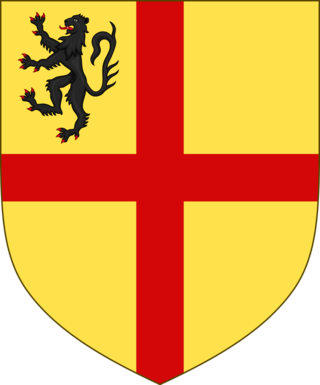
Sir Uilleag (Ulick) de Burgh (Burke), 1st Clanricarde or Mac William Uachtar was an Irish chieftain and noble who was leader of one of the three factions who fought the Burke Civil War in the 1330s. By the end of the conflict he had established himself and his descendants as Clanricarde, also known as Mac William Uachtar, independent lords of Galway. He was succeeded by his son, Richard Óg Burke, 2nd Clanricarde (d.1387).
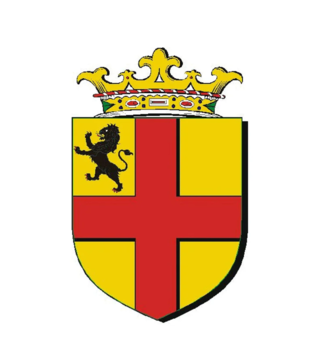
Clanricarde, also known as Mac William Uachtar or the Galway Burkes, were a fully Gaelicised branch of the Hiberno-Norman House of Burgh who were important landowners in Ireland from the 13th to the 20th centuries.
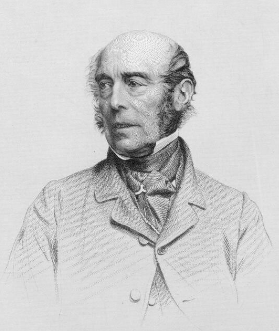
Ulick John de Burgh, 1st Marquess of Clanricarde, styled Lord Dunkellin until 1808 and the Earl of Clanricarde from 1808 until 1825, was a British Whig politician who served as British Ambassador to Russia (1838–40), Postmaster General (1846–52) and Lord Keeper of the Privy Seal (1858).

Ulick MacRichard Burke, 1st Marquess of Clanricarde, 5th Earl of Clanricarde, 2nd Earl of St Albans, styled Lord Dunkellin until 1635, was an Anglo-Irish nobleman who was involved in the Wars of the Three Kingdoms. A Catholic Royalist who had overall command of the Irish forces during the later stages of the Cromwellian conquest of Ireland, he was created Marquess of Clanricarde (1646).

Henry Jermyn, 3rd Baron Jermyn and 1st Baron Dover, 1st Jacobite Earl of Dover PC was an English courtier, peer and favourite of James II.
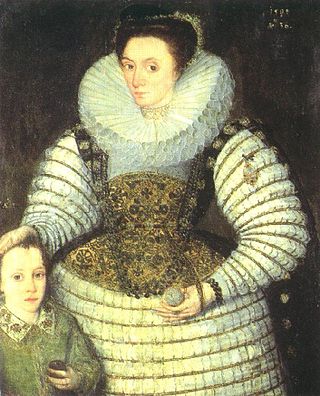
Frances Burke, Countess of Clanricarde, Dowager Countess of Essex was an English noblewoman. The daughter of Sir Francis Walsingham, Elizabeth I's Secretary of State, she became the wife of Sir Philip Sidney at age 16. Her second husband was Queen Elizabeth's favourite, Robert Devereaux Earl of Essex, with whom she had five children. Two years after his execution in 1601, she married Richard Burke, Earl of Clanricarde, and went to live with him in Ireland.
Richard Burke, 4th Earl of Clanricarde, styled Lord Dunkellin until 1601, was an Irish nobleman and politician.
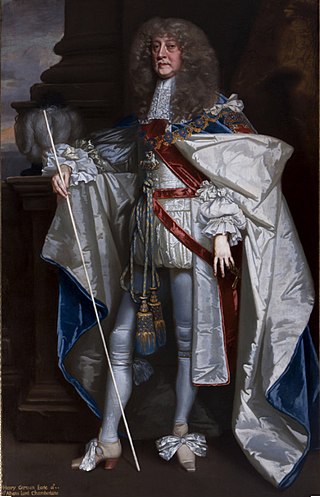
Baron Jermyn, of St Edmundsbury, was a title in the Peerage of England.

William Paulet, 4th Marquess of Winchester was an English nobleman, the son of William Paulet, 3rd Marquess of Winchester and Anne or Agnes Howard. He was styled Lord St. John from 1576 to 1598. He was summoned to Parliament on 16 January 1581 in his father's barony as Lord St. John. On 24 November 1598, he succeeded his father as 4th Marquess of Winchester. Paulet experienced great financial difficulties arising from his magnificent style of living and his lavish entertainment of Elizabeth I at Basing House.
Richard or Dick Burke may refer to:

de Burgh is an Anglo-Norman surname deriving from the ancient Anglo-Norman and Hiberno-Norman noble dynasty, the House of Burgh. In Ireland, the descendants of William de Burgh (c.1160–1206) had the surname de Burgh which was gaelicised in Irish as de Búrca and over the centuries became Búrc then Burke and Bourke.
Ulick Burke, 3rd Earl of Clanricarde, styled Lord Dunkellin until 1582, was an Irish peer who was the son of Richard Burke, 2nd Earl of Clanricarde and Margaret O'Brien.

William Burke, 7th Earl of Clanricarde, PC (Ire), was an Irish peer who fought in his youth together with his brother Richard, 6th Earl of Clanricarde under their cousin, Ulick Burke, 1st Marquess of Clanricarde against the Parliamentarians in the Cromwellian conquest of Ireland. He succeeded his brother as the 7th Earl in 1666.
The Governor of Galway was a military officer who commanded the garrison at Galway in the west of Ireland. The post became a sinecure and in 1833 was to be abolished from the next vacancy.












